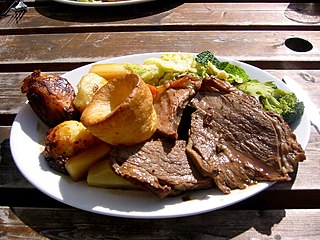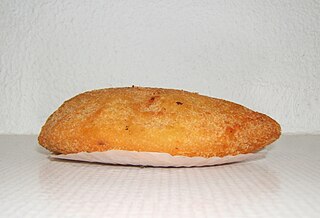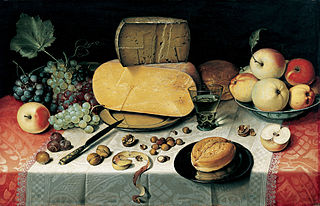
Gravy is like a sauce, often made from the juices of meats that run naturally during cooking and often thickened with wheat flour or corn starch for added texture. The gravy may be further coloured and flavored with gravy salt or gravy browning or ready-made cubes and powders can be used as a substitute for natural meat or vegetable extracts. Canned and instant gravies are also available. Gravy is commonly served with roasts, meatloaf, rice, noodles and mashed potatoes.

A Sunday roast is a traditional British main meal that is typically served on Sunday, consisting of roasted meat, roast potatoes or mashed potatoes, and accompaniments such as Yorkshire pudding, stuffing, gravy and mint sauce. Vegetables such as cauliflower, roast parsnips, Brussels sprouts, peas, carrots, runner beans, and broccoli can be part of the dish. The Sunday roast is also popular in many parts of Ireland, especially in most of Ulster.

Goulash is a soup of meat and vegetables seasoned with paprika and other spices. Originating in Hungary, goulash is a common meal predominantly eaten in Central Europe but also in other parts of Europe. It is one of the national dishes of Hungary and a symbol of the country.

Mashed potato or mashed potatoes, colloquially known as mash, is a dish of mashing boiled potatoes, usually with added milk, butter, salt and pepper. It is generally served as a side dish to meat or vegetables. When the potatoes are only roughly mashed, they are sometimes called smashed potatoes.

Kitchenware are the tools, utensils, appliances, dishes, and cookware used in food preparation, or the serving of food. Kitchenware can also be used to hold or store food before or after preparation.

A rissole is a small patty enclosed in pastry, or rolled in breadcrumbs, usually baked or deep fried. The filling has savory ingredients, most often minced meat, fish or cheese, and is served as an entrée, main course, or side dish.

Cholent or hamin is a traditional Jewish stew. It is usually simmered overnight for 12 hours or more, and eaten for lunch on Shabbat. Cholent was developed over the centuries to conform with Jewish laws that prohibit cooking on the Sabbath. The pot is brought to a boil on Friday before the Sabbath begins, and kept on a blech or hotplate, or left in a slow oven or electric slow cooker, until the following day. Cholent originated in ancient Judea, possibly as far back as the Second Temple period, and over the centuries various Jewish diaspora communities created their own variations of the dish.

A potato ricer is a kitchen implement used to process potatoes or other food by forcing it through a sheet of small holes, which are typically about the diameter of a grain of rice.

Arab cuisine is the cuisine of the Arabs, defined as the various regional cuisines spanning the Arab world, from the Maghreb to the Fertile Crescent and the Arabian Peninsula. The cuisines are often centuries old and reflect the culture of great trading in spices, herbs, and foods. The three main regions, also known as the Maghreb, the Fertile Crescent, and the Arabian Peninsula, have many similarities, but also many unique traditions. These cuisines have been influenced by the climate, cultivating possibilities, as well as trading possibilities.

Hyderabadi biryani is a variety of biryani from Hyderabad, India. It is prepared from rice using the dum method of cooking, and is a common feature in Hyderabadi weddings.

A side dish, sometimes referred to as a side order, side item, or simply a side, is a food item that accompanies the entrée or main course at a meal.

Maqluba or Maqlooba is a traditional Iraqi, Lebanese, Palestinian, Jordanian, and Syrian dish served throughout the Levant. It consists of meat, rice, and fried vegetables placed in a pot which is flipped upside down when served, hence the name maqluba, which translates literally as "upside-down." The dish goes back centuries and is found in the Kitab al-Tabikh, a collection of 13th century recipes.

Gratin is a culinary technique in which an ingredient is topped with a browned crust, often using breadcrumbs, grated cheese, egg or butter. Gratin is usually prepared in a shallow dish of some kind. A gratin is baked or cooked under an overhead grill or broiler to form a golden crust on top and is often served in its baking dish.

Palestinian cuisine consists of foods from or commonly eaten by Palestinians—, Palestinian, Jordan, refugee camps in nearby countries as well as by the Palestinian diaspora. The cuisine is a diffusion of the cultures of civilizations that settled in the region of Palestine, particularly during and after the Islamic era beginning with the Arab Ummayad conquest, then the eventual Persian-influenced Abbasids and ending with the strong influences of Turkish cuisine, resulting from the coming of the Ottoman Turks. It is similar to other Levantine cuisines, including Lebanese, Syrian and Jordanian.

Lontong is an Indonesian dish made of compressed rice cake in the form of a cylinder wrapped inside a banana leaf, commonly found in Indonesia, Malaysia and Singapore. Rice is rolled inside a banana leaf and boiled, then cut into small cakes as a staple food replacement of steamed rice. The texture is similar to those of ketupat, with the difference being that the ketupat container is made from woven janur fronds, while lontong uses banana leaf instead.

A croquette (/kroʊˈkɛt/) is a small cylinder of food consisting of a thick binder combined with a filling, which is breaded and deep-fried, and served as a side dish, a snack, or fast food worldwide.

Kuku, also spelled as kookoo, is an egg-based and often vegetarian Iranian dish made of whipped eggs folded in various ingredients. It is similar to the Italian frittata, the French quiche, or an open-faced omelette, but it typically has less egg than a frittata, and it cooks for a shorter amount of time, over a low heat, before turned over or grilled briefly to set the top layer. It is served either hot or cold as a starter, side dish or a main course, and is accompanied with bread and either yogurt or salad. In parts of northern Iran, kuku might be used as a midday meal, and might be served with either plain cooked rice (kate) or bread.

Okoy or ukoy, are Filipino crispy deep-fried fritters made with glutinous rice batter, unshelled small shrimp, and various vegetables, including calabaza, sweet potato, cassava, mung bean sprouts, scallions and julienned carrots, onions, and green papaya. They are traditionally served with vinegar-based dipping sauces. They are eaten on their own or with white rice. They are popular for breakfast, snacks, or appetizers. Okoy are sometimes dyed bright orange with achuete seeds.

Indo cuisine is a fusion cooking and cuisine tradition, mainly existing in Indonesia and the Netherlands, as well as Belgium, South Africa and Suriname. This cuisine characterized of fusion cuisine that consists of original Indonesian cuisine with Eurasian-influences—mainly Dutch, also Portuguese, Spanish and British—and vice versa. Nowaday, not only Indo people who consume Indo cuisine, but also Indonesians and Dutch people.



















